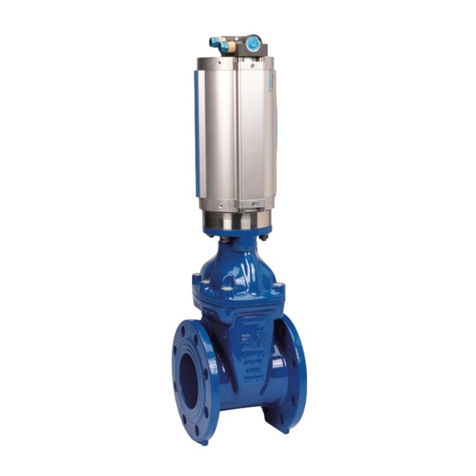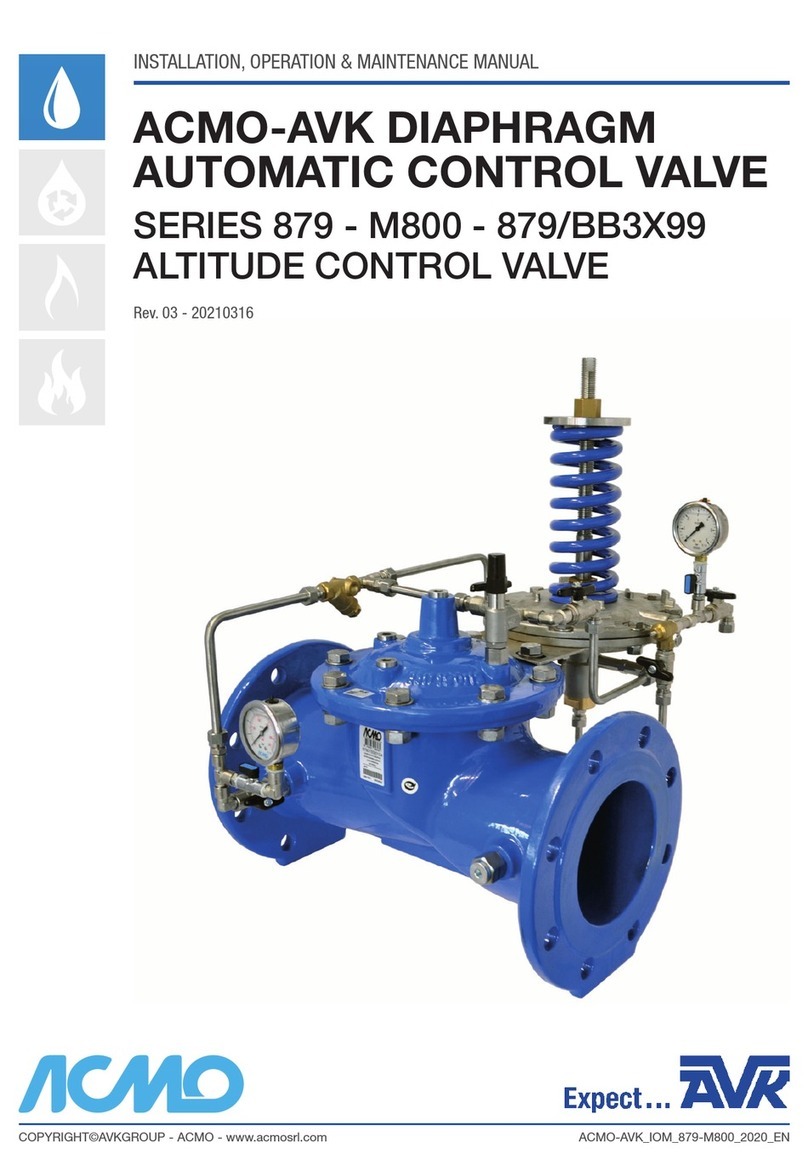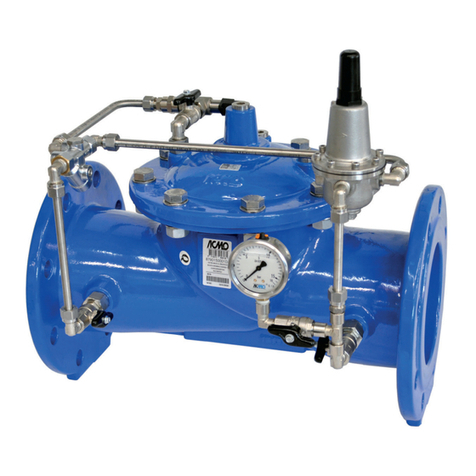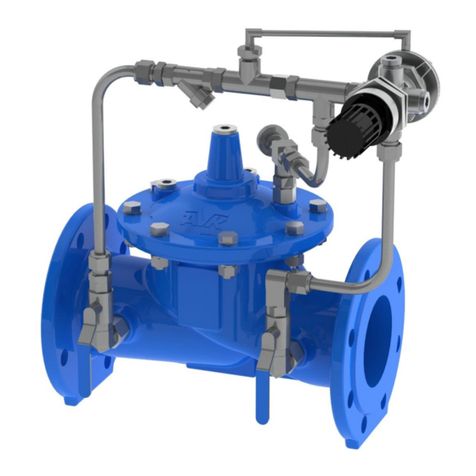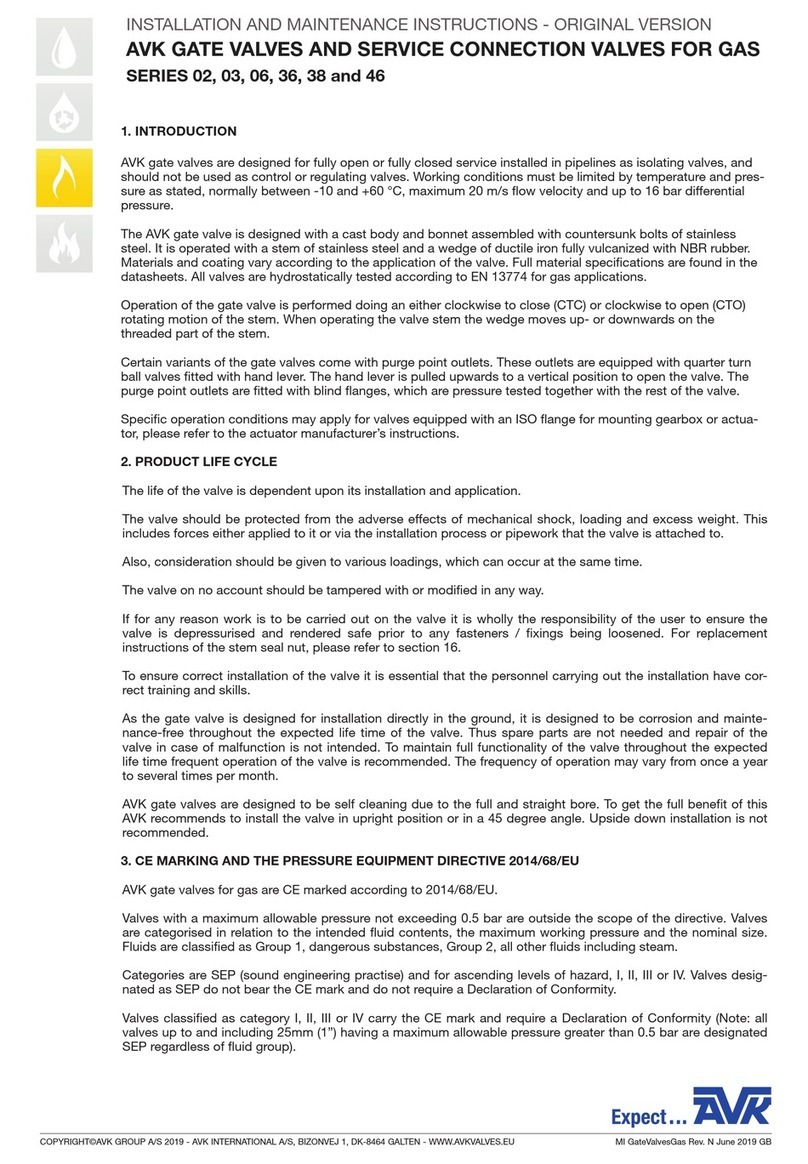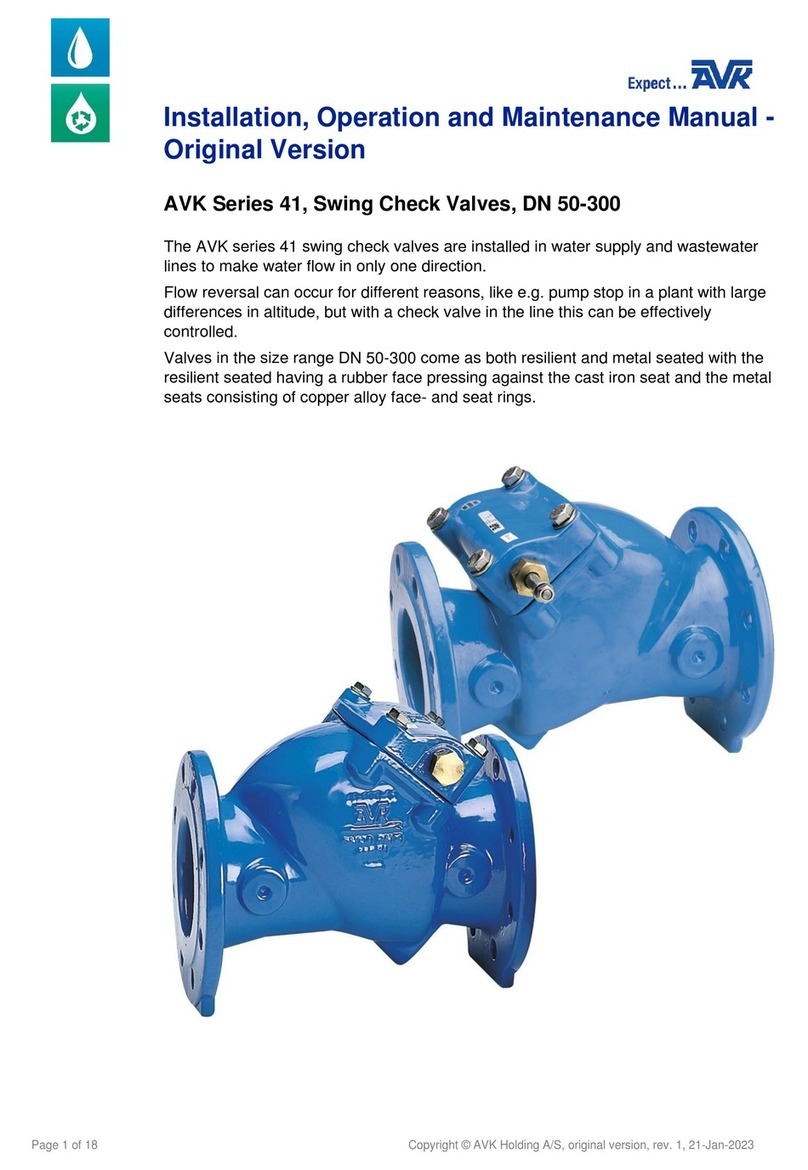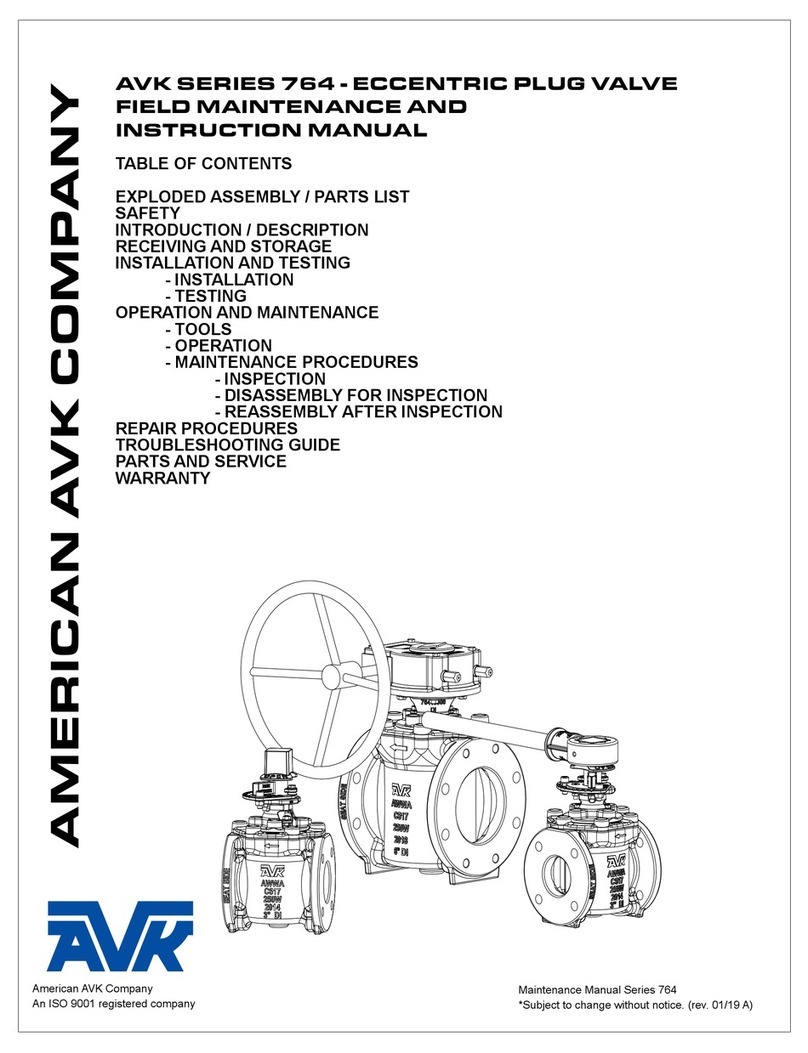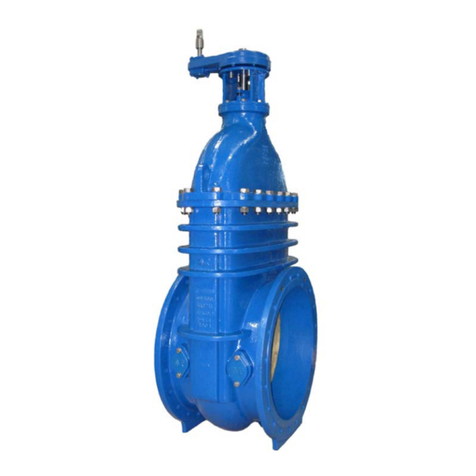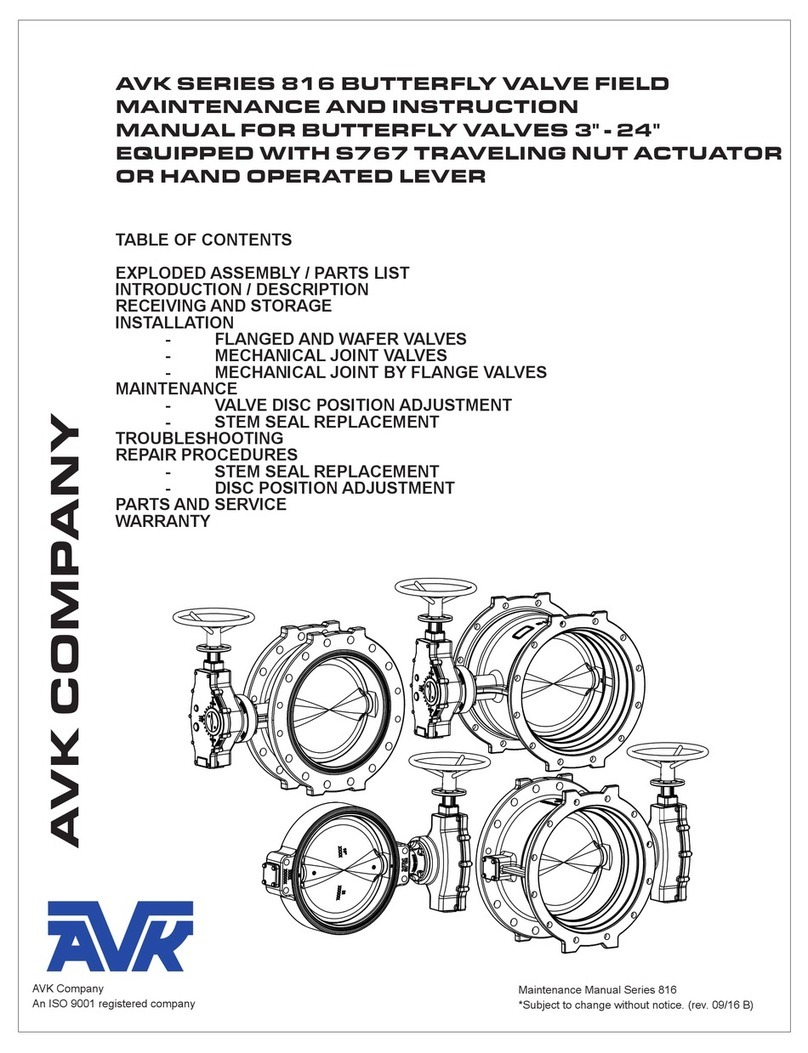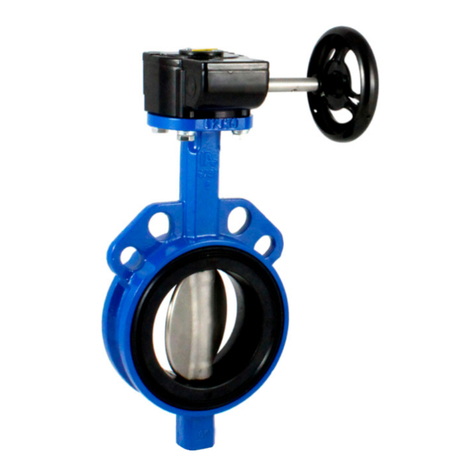
INSTALLATION, OPERATION AND MAINTENANCE MANUAL – ORIGINAL VERSION
AVK GATE VALVES FOR WATER AND FIRE PROTECTION
SERIES 145
Page 10/12 MI GateValve 145 rev. AC 2020 GB
7.2 OS&Y VALVE REPAIRS
7.2.1 HANDWHEEL REPLACEMENT (Fig. 5A and 5B)
WARNING
To perform the following steps, make sure that the water
main supply line has been shut off and that the pressure has
been bled off!
NOTE
As most OS&Y valves are used in fire protection applications,
verify that any alarm system has been disabled prior to
performing any maintenance or repair.
1. Remove the hot melt glue that covers the bonnet bolts
(F216) using a small, flat bladed screwdriver (Fig. 5A).
2. Once the hot melt glue has been removed, use a 5/16”
(8mm) Allen wrench to remove the DN65 valve bonnet
bolts (F216) and a 3/8” (10mm) Allen wrench for valve
sizes DN80-200.
3. Turn the remaining part of the handwheel (F202) in the
closing direction. This will lift the yoke/bonnet (F263)
head assembly, allowing removal of the upper stem nut
(F201) from the stem assembly (F215).
4. Remove the upper half of the stem nut (F201) from the
handwheel and place it in the new handwheel (F202).
NOTE: The stem nut pair is keyed with different sized
lugs. Make sure to align the lugs in the correct location
(Fig. 5B)!
5. Align the upper stem nut (F201) with the lower stem nut
(F205), and ensure that there is full engagement of the
lugs.
6. Carefully turn the handwheel (F202) in the opening
direction until the yoke/bonnet (F263) is fully down and
resting on the body (F219).
CAUTION: When lowering the head assembly back on
the body, ensure that the bonnet gasket (F218) is not
damaged.
7. Install the bonnet bolts (F216), ensuring they are inserted
through the bonnet gasket (F218) and tighten in a
diametrically opposite pattern.
8. To replace the protective hot melt glue over the bonnet
bolts, use any EPA approved caulk or hot melt glue.
9. Repressurise the system. If there is a leak around the
stem seal O-ring area, make sure that the upper gland
follower bolts (F261) are screwed down evenly into the
bonnet/yoke (F263). Tighten the nuts 1/4 turn each until
the leak stops.
NOTE: Since UL, ULC and FM approvals are for the
manufacturer, this procedure will have no effect on
listings or approvals.
page 10
OS&Y (Outside Stem & Yoke) VALVE REPAIRS:
HANDWHEEL REPLACEMENT (Figs.6A,6B)
WARNING: To perform the following steps, be sure the Water
Main Supply Line has been shut off, and that the pressure has
been bled off!
NOTE: As most OS&Y valves are used in fire protection
applications, verify that any alarm systems have been
disabled prior to performing any maintenance or repairs.
1. Using a small, at bladed screwdriver, remove the hot melt
glue that covers the Bonnet Bolts (F216).
( See Fig. 6A )
2. Once the hot melt glue has been removed, use 5/16", or 8mm
Allen wrench to remove the 2½" valve Bonnet Bolts (F216),
and a 3/8”, or 10mm Allen wrench for valve sizes 3"- 8".
3. Turn the remaining part of the Handwheel (F202) in the
closing direction. This will lift the Yoke/Bonnet (F263) head
assembly, allowing removal of the Upper Stem Nut (F201),
from the Stem Assembly (F215).
4. Remove the upper half of the Stem Nut (F201) from the
handwheel and place it in the “new Handwheel” (F202).
NOTE: The Stem Nut pair are keyed with different sized lugs.
Be sure to align the lugs in the correct location!
(See Fig. 6B)
5. Align the Upper Stem Nut (F201), with the Lower Stem Nut
(F205), And insure that there is full engagement of the lugs.
6. Carefully turn the Handwheel (F202) in the opening direction
until the Yoke/Bonnet (F263), is fully down and resting on the
Body (F219).
CAUTION: When lowering the head assembly back on the body,
take care to ensure that the Bonnet Gasket (F218), is not
damaged.
7. Install the Bonnet Bolts (F216), taking care to ensure they are
inserted through the Bonnet Gasket (F218), and tighten in a
diametrically apposed pattern.
8. To replace the protective hot melt glue over the Bonnet Bolts,
use any EPA approved caulk, or hot melt glue.
9. Repressurize the system. At this time, if there is a leak
around the Stem Seal O-ring area, be sure that the upper
Gland Follower Bolts (F261) are screwed down evenly in to
the Bonnet/Yoke (F263). Tighten the nuts 1/4 turn each until
the leak stops.
NOTE: Since UL , ULC and FM Approvals are for the
Manufacturer, this procedure will have no effect on
listings or approvals.
Fig. 6A
Fig. 6B
F201
F202
F263
F215
OS&Y Stem Nut Pair (F201
andF205) are drilled and
tapped as a pair
F201
F205
F205
F219
Fig. 5A
page 10
OS&Y (Outside Stem & Yoke) VALVE REPAIRS:
HANDWHEEL REPLACEMENT (Figs.6A,6B)
WARNING: To perform the following steps, be sure the Water
Main Supply Line has been shut off, and that the pressure has
been bled off!
NOTE: As most OS&Y valves are used in fire protection
applications, verify that any alarm systems have been
disabled prior to performing any maintenance or repairs.
1. Using a small, at bladed screwdriver, remove the hot melt
glue that covers the Bonnet Bolts (F216).
( See Fig. 6A )
2. Once the hot melt glue has been removed, use 5/16", or 8mm
Allen wrench to remove the 2½" valve Bonnet Bolts (F216),
and a 3/8”, or 10mm Allen wrench for valve sizes 3"- 8".
3. Turn the remaining part of the Handwheel (F202) in the
closing direction. This will lift the Yoke/Bonnet (F263) head
assembly, allowing removal of the Upper Stem Nut (F201),
from the Stem Assembly (F215).
4. Remove the upper half of the Stem Nut (F201) from the
handwheel and place it in the “new Handwheel” (F202).
NOTE: The Stem Nut pair are keyed with different sized lugs.
Be sure to align the lugs in the correct location!
(See Fig. 6B)
5. Align the Upper Stem Nut (F201), with the Lower Stem Nut
(F205), And insure that there is full engagement of the lugs.
6. Carefully turn the Handwheel (F202) in the opening direction
until the Yoke/Bonnet (F263), is fully down and resting on the
Body (F219).
CAUTION: When lowering the head assembly back on the body,
take care to ensure that the Bonnet Gasket (F218), is not
damaged.
7. Install the Bonnet Bolts (F216), taking care to ensure they are
inserted through the Bonnet Gasket (F218), and tighten in a
diametrically apposed pattern.
8. To replace the protective hot melt glue over the Bonnet Bolts,
use any EPA approved caulk, or hot melt glue.
9. Repressurize the system. At this time, if there is a leak
around the Stem Seal O-ring area, be sure that the upper
Gland Follower Bolts (F261) are screwed down evenly in to
the Bonnet/Yoke (F263). Tighten the nuts 1/4 turn each until
the leak stops.
NOTE: Since UL , ULC and FM Approvals are for the
Manufacturer, this procedure will have no effect on
listings or approvals.
Fig. 6A
Fig. 6B
F201
F202
F263
F215
OS&Y Stem Nut Pair (F201
andF205) are drilled and
tapped as a pair
F201
F205
Fig. 5B




